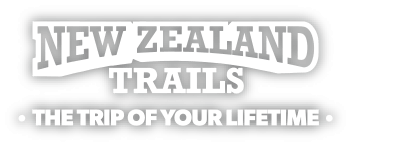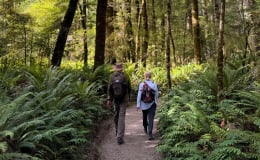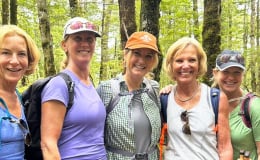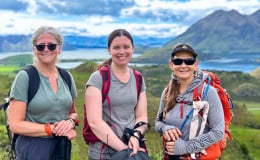
Hiking the Milford Track in Winter
Voted by some as the World’s Best Walk, the Milford Track is a journey through wilderness in all its natural glory, crossing mountains and valleys carved by the forces of nature. The track is inaccessible by road at either end, requiring a boat journey via either an alpine lake or glacial fjord to reach the ends of this 33-mile (53 kilometer) track through paradise. However, during winter the same forces that shaped the incredible natural landscape of the Milford Track make hiking on this famous trail an altogether different undertaking compared to the Great Walks hiking season of October till April.

Snow-capped peaks make Spring in Fiordland even more magical.
Winter Weather on the Milford Track
With its location on the south-western coast of New Zealand’s South Island, Fiordland National Park, home to the Milford Track, is known for its weather extremes, particularly in winter. The region receives an average of 5 meters (16ft) of rainfall per year, and although the lush forests and river valleys which make up the area are well equipped to deal with this most of the year, in winter this rain can fall as snow as temperatures commonly drop below freezing level (0’C, 32F) overnight. Due to the temperate rainforest in the area, the daytime temperatures don’t get as low as other regions of the South Island, with daily highs of around 10’C/50F, meaning this snow generally doesn’t last long before falling from the steep valleys or melting into the various rivers that fill the valley floors. While it rains less in the winter months here than the rest of the year, the cooler conditions mean the ground doesn’t dry out as quickly causing the ground to soften and increasing the chance of slips, as well as damage to the delicate flora and fauna.

Conditions on the Milford Track in Winter
As one of New Zealand’s Great Walks, the Milford Track is very well maintained by local rangers, with bridges, steps and serviced huts along the way to make it a multi-day hike suitable for people of all ages and abilities. Due to the weather extremes over winter most of these features are only available in the Great Walks season of October to April, with bridges removed and hut services reduced to discourage people from attempting it out of season. This is done for the safety and well-being of hikers, and while is it still possible to complete the hike between May and September, is it only suitable for people with considerable outdoor experience and suitable equipment, such as crampons, ice axes and emergency shelters. Even then it is always advised to check with a local Department of Conversation office before attempting the hike to get an up-to-date weather and track report. DoC (Department of Conversation) also uses this off-season to carry out any major maintenance on the track which isn’t possible during the busy summer months. This means the track is usually in its best condition in October when the hiking season begins and we get back out on the trails on our fully guided New Zealand adventures.
Getting to the Milford Track
Like many of New Zealand’s Great Walks, the Milford Track is a point-to-point track meaning alternative transport is required to get to either end of the trail. Milford Track is also unique in that it can only be hiked in one direction, East to West, when booking the huts. This is done to control numbers of hikers on the trail and ensure one way traffic on the narrow points of the trail. It is also great as it means groups starting together generally stay together over the four days, building a great comradery along the way.
The start of the trail is accessed by boat across lake Te Anau, with the departure 30 minutes' drive from the Te Anau township which is the closest place to stay. These boats run scheduled departures in the hiking season but only private charter trips over the winter months. At the end of the trail, a short boat trip is also needed to travel from the trailhead at Sandfly Point back to Milford Sound terminal and gateway to the famous Milford Sound cruise. At New Zealand Trails, we generally catch this short boat trip to the end of the trail and walk our favourite section of the hike in the morning before the multi-day hikers arrive. We then head back in time to spend a relaxing afternoon on a cruise of Milford Sound before returning to Te Anau for a hot shower and buffet dinner, no bunk rooms or heavy packs required. For those wanting to complete the full four-day track, there are several companies who offer transport packages, but track bookings are very limited and often sell out months in advance, so you need to get in early.
Enjoy the Milford Track with New Zealand Trails
While beautiful all year round, there is a Great Walks season for a reason. This window between October and April is created to ensure not only the safety of the hikers but also the stunning flora and fauna that draws people here in the first place. While extremely popular over the summer months, early and late in the season is the perfect time to visit this magical place, particularly at the beginning of October/November. Freshly opened for the year, the track is in its best condition while snow still caps the surrounding mountains adding to the beauty. Spring also rings in the new birdlife, with a melody of song filling the valleys each morning. Whether heading out on the full 33-mile (53km) trail or joining us to hike our favourite section as part of our visit to Milford Sound, the Milford Track is a special place that unlike many places anointed as the “the world's best”, actually manages to exceed expectations for all those lucky enough to visit.

Experience the lush greenery of the Milford Track in Great Walks season.
If you want to explore the beauty of the Milford Track with an experienced local guide and experience all New Zealand has to offer then check out our all-inclusive New Zealand hiking and adventure tours. With our incredible local guides, you’ll do New Zealand in comfort and style. Ticking off the must-see spots like Milford Sound and Aoraki/Mt Cook while also discovering the off-the-beaten-track hidden gems that only we locals know. Discovering the real New Zealand with real New Zealanders. If you’d like to find out more grab a copy of your FREE BROCHURE HERE or get in touch – we’d love to chat!







